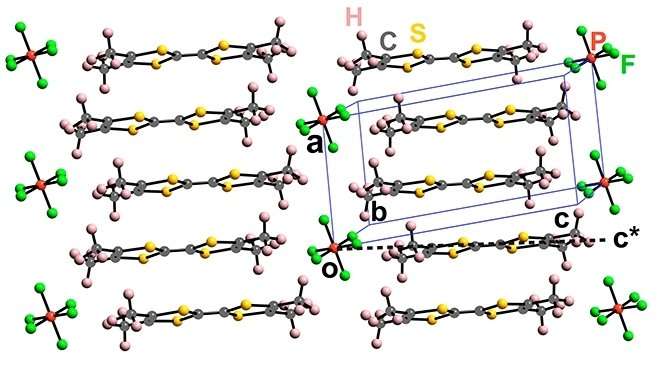Research reveals new aspects of superconductivity and correlated phenomena

Discovered accidentally over a century ago, the phenomenon of superconductivity inspired a technological revolution. In 1911, while studying the behavior of solid mercury supercooled to 4 K (-269 °C), Dutch physicist Heike Kamerlingh Onnes (1853-1926) observed for the first time that certain materials conduct electricity without resistance or losses at temperatures in the vicinity of absolute zero.
Interest revived in the 1980s when superconductivity was experimentally observed at much higher temperatures in the range of 90 K (-183 °C). This record was later surpassed, and scientists now seek superconductivity at room temperature.
This information provides the background for a study recently conducted by the Solid State Physics Group at São Paulo State University (UNESP) in Rio Claro, Brazil. The principal investigator was Valdeci Pereira Mariano de Souza. In addition to other researchers affiliated with UNESP, the team included scientists from Paris South University (Orsay) in France.
In Rio Claro, the research team used equipment purchased with support from the São Paulo Research Foundation - FAPESP to obtain the results, which provided the basis for an article published in Physical Review B.
"In several materials, the superconductive phase is manifested in the proximity of what's known as the Mott insulating phase. The Mott metal-insulator transition is a sudden change in electrical conductivity that occurs at a given temperature when the Coulomb repulsion between electrons becomes comparable to the free-electron kinetic energy," said Mariano.
"When the Coulomb repulsion becomes relevant, the electrons that were itinerant become localized, and this minimizes the system's total energy. This electron localization is the Mott insulating phase. In some cases, an even more exotic process unfolds. Because of the interactions between electrons occupying neighboring sites in the network, the electrons rearrange themselves in the network in a non-homogeneous manner, and a so-called 'charge ordering phase' occurs. Our study addressed this kind of phenomenon."
When the charge ordering phase occurs, the non-homogeneous charge distribution, which is sometimes accompanied by a distortion of the crystalline network, makes the material electrically polarized, and as a result, it behaves like a ferroelectric material. This stage is known as the "ferroelectric Mott-Hubbard phase" after two British physicists who studied the topic: Nevill Mott (1905-96), 1977 Nobel Laureate in Physics, and John Hubbard (1931-80).
To experimentally explore these exotic phases, the UNESP researchers chose a material called Fabre salts, which are formed from an organic molecule, tetramethyltetrathiafulvalene (TMTTF), with a symmetrical configuration comprising a central double carbon bond and two methyl radicals on either side. They used a cryostat, also acquired with FAPESP's support, to reach the coldest and most magnetic point available at UNESP, with a temperature of 1.4 K and a 12 Tesla field.
"With this experimental setup, we aimed not just to characterize materials, although that's important, but to investigate the fundamental properties of matter that manifest themselves under extreme conditions," Mariano said. "Fabre salts have extremely rich phase diagrams for those who undertake this kind of research. The molecular systems concerned had already been explored using nuclear magnetic resonance imaging, infrared spectroscopy and other techniques. What we essentially did was measure their dielectric constants in the low-frequency regime."
It is worth recalling that the dielectric constant varies from material to material and, while it is a macroscopic quantity, it tells us how polarizable a material is.
"Given that Fabre salts are highly anisotropic and therefore have strongly crystallographic-direction-dependent transport properties, when charge ordering occurs, we observe Mott-Hubbard electric polarization throughout the TMTTF stack. This polarization is considerable and was reported in the literature in 2001," said the FAPESP-supported researcher.
"The ionic contribution to the dielectric constant of these materials was measured for the first time in this study. We found that as the temperature decreases, the ionic contribution also decreases, which gives rise to the Mott-Hubbard phase. This was a new observation that had not yet been reported in the literature - a genuinely original contribution of ours. We also explored the effect of the disorder induced by irradiation in the Mott-Hubbard phase in detail."
This is important, he added, because of the proximity of the Mott-Hubbard ferroelectric phase to superconductivity.
"William Little, Emeritus Professor of Physics at Stanford University, stated that low-dimensional molecular conductors would be candidates for obtaining room temperature superconductivity. In his work, Little proposed that room temperature superconductivity would be achieved by means of 'spines', or conducting chains with highly polarizable side chains. The materials we're studying have precisely these elements," Mariano said.
The production of spines was a first step. The next step, which has already been conceived by the researchers in Rio Claro, is to stress Fabre salts to induce superconductivity in the Mott-Hubbard ferroelectric phase.
More information: Mariano de Souza et al, Probing the ionic dielectric constant contribution in the ferroelectric phase of the Fabre salts, Physical Review B (2018). DOI: 10.1103/PhysRevB.97.045122
Journal information: Physical Review B
Provided by FAPESP



















